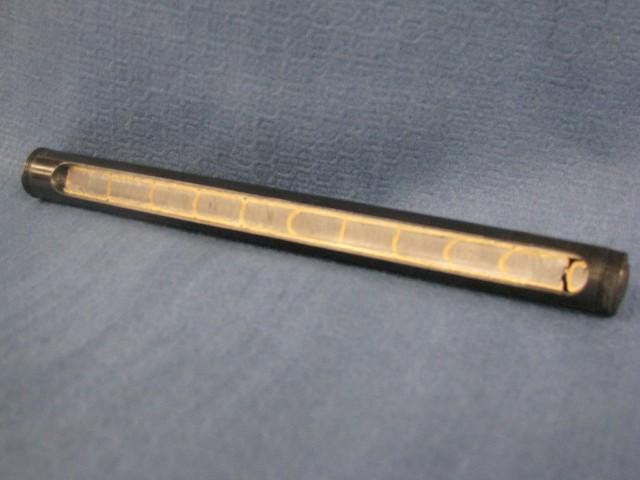J E Custom
Well-Known Member
I'm not going along just because a few guys got away with it. I'm saying major firearms manufacturers are designing and building guns for mass consumption that push these 'limits".
JE, What do you think about S&W using barrels of about .109" thick on the 500 S&W rated for everyday use at 60,000 PSI and Dan Wesson using barrels .500" diameter for the .357 Magnum at 35,000psi? The proof loads for these guns are rated at 50% over these figures. How much pressure do you think a 300 RUM left in the barrel when the bullet is at the very end of the barrel?
I don't know the exact pressure either but I have bobbed a number of them with a slight bulge from firing a slug of mud out of them. Not one was ever split. As far as support from the brake threads as long as the brake has any tension at all the v portion of the threads in the brake is firmly contacting the corresponding v form from the barrel. It doesn't need filled solid to gain support.
I have a Rifles Inc 300 RUM in my shop right now that had a 7/16-28 brake on it and I was just reminded that Kimber Mountain Ascent rifles use 7/16-28 threads on their 30 cal rifles.
Here is the math on these popular revolvers. I'm guessing somebody of at least one of these companies consulted an engineer before pouring millions into making these firearms.
.718" -.500" = .109" is capable of regular use at 60,000psi
.500" - .357 = .0715" is capable of regular use at 35,000psi.
I have also noticed a lot of semi automatic high powered pistols that have very thin barrels that operate at 37,500 to 40,000 psi. Then there are the fluted cylinders on these revolvers. Many of which get down to less than .100 thick. I have also brought it up with the owners of several barrel makers and I doubt any of them are engineers but they have no problem fluting barrels down pretty thin. They frequently say the pressure curve drops of dramatically after a few inches down the barrel. I worry a lot more about the guys asking for the chamber shank be reduced right at the lug to as small as possible leaving the chamber with not much thickness right at the throat. I have yet to do it due to crazy cost of the Proof research barrels but I suspect they are very thin under that epoxied on carbon sleeve. Especially on the .375 CheyTac barrels.
I have a Dan Wesson .357 barrel with Eleven 158 grain jacketed soft point bullets in it and it only bulged to .513" right outside the frame. Of course my word means nothing here so I'll let the picture do the talking. It's the best conversation starter of all my wall of shame examples.

I hear everything you are saying and agree that these things do exist. as far as the pressure at the muzzle of a rifle or pistol It is normally somewhere between 10,000 to 17,000 psi at the muzzle,
Chamber pressure is much higher and this is where the SAMMI pressure specification is set. on revolvers it is normally lower because of the gas loss between the cylinder and the barrel. Most revolvers fail at the cylinder from the max pressure. The fluted cylinders normally have the flutes between the cylinder bores so as not to weaken the cylinder. Most shotguns fail just in front of the receiver where there is no extra support. Rifles generally fail near the muzzle (About 2/3 rds from the action and continue to the muzzle. If the barrel splits soon enough and can relieve most of the pressure,
a muzzle device can sometimes stop the barrel from splitting all the way, but often as not it just shoots the brake off if the barrel wall is two thin.
Here is a link to some barrel failures that proves that it does happen and can be prevented.
https://www.google.com/search?q=rif...4eYCw#imgrc=yQ5P6r7G5K3djM:&spf=1495079543300
I was worried about wall thickness when I found a rifle that had a bulge in the bore of only .004 to .006 thousandths about 8'' from the muzzle. You could not see it but while cleaning it you could feel the patch get loose and then tight again. It was a fluted barrel that the flutes were two deep and did/could not support the pressure. I replaced the barrel with a non fluted barrel and later decided to cross section the barrel, the web between the bottom of the flutes and the bore was less that .100 thousandths. (Of course the pressure would be higher at this point but the failure occurred anyway.
I have seen many of these failures but never had one of my weapons fail except for the one mentioned, and I considered it was caused by a very bad fluting job and for many years I would not own a fluted barrel because of it. Once I talked to the favorite barrel maker he convinced me that proper fluting was not the problem but poor fluting and not enough wall thickness. (This is why most barrel makers will not flute or warranty fluting on a barrel below a certain contour because of the wall thickness issue.
I am probably to conservative but It has served me well and I don't want to be one of those shooters in the link that found out the hard way. or find out that some of the work that I performed failed and possibly hurt someone.
Over the years I have declined to do something that I though was marginal because of my concern
with it and to date have a 100% clean record from failures, and will stick with my philosophy. Why take a chance, Murphy is always out there and ready to pounce.
Just My Opinion
J E CUSTOM
